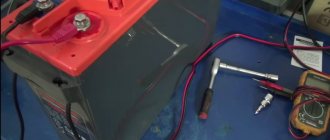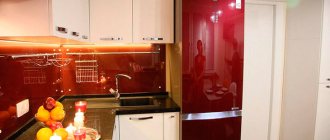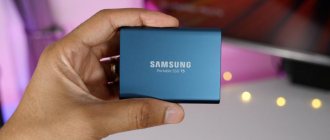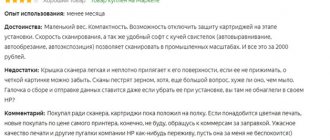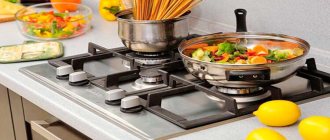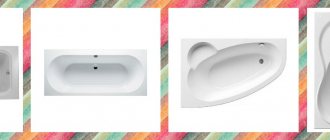Ten batteries - all from famous brands. This is why we were so surprised by the results.
It looks like traditionally designed batteries will rule the roost for a long time to come. Until recently, we predicted that they would be replaced by more advanced batteries made using AGM technology. But for economic reasons, manufacturers decided not to completely replace ancient batteries with more advanced ones. The inappropriateness of such castling was confirmed by the results of our special test, where we compared batteries of five different types (No. 10, 2019).
Therefore, for the traditional annual examination, we bought “European” ones with liquid electrolyte and dimensions 278 x 175 x 190 mm. Such batteries are among the most popular in Russia, suitable for both most budget cars and models costing several million rubles.
Usually we gathered a larger group, but this time we decided not to take “whipping boys.” However, along with well-known brands, there is also a newcomer - the South Korean Sepe battery. It is made at the same Delkor plant that produced Medalist batteries, which repeatedly won our tests. Today, Medalist batteries are also produced in Turkey, but we have Korean products in our test. So, four “Russians” against six “foreigners”. The cheapest battery is Tyumen: 4,000 rubles. The most expensive is Korean Sepe: 7,300 rubles.
The test program is based on testing the energy capabilities of batteries in cold weather: at -18 and -29 °C. For Russian operating conditions, these are the most important indicators. In addition, the reserve capacity of all batteries was assessed both as delivered and after being fully charged. The first parameter speaks about the integrity of the seller: all batteries were sold as under warranty, but this does not mean that someone took care of them. The second parameter is the actual energy reserve in the battery, which is what we took into account when allocating seats. A total of four energy indicators were checked.
Just for fun, we compared the ability of batteries to accept charging current, assessing their recovery after a deep discharge. And in order to evaluate the benefits of purchasing a particular battery, we recalculated the points scored by the batteries taking into account their price - we got a new table of ranks in terms of price and quality ratio.
The best half of the ranking 2021
At first everything went very smoothly. The reserve capacity of the batteries turned out to be quite good - over one hundred minutes. In previous years' examinations, most of the results were more modest. But the reserve capacity, as is known, is tested in greenhouse conditions: at a modest current of 25 A and a temperature of 25 ° C. What will happen with three-digit currents and in the cold?
Alarming notes rang out immediately. Titan, when assessing the cold cranking current at the very first measurements, sank below 7 V - not a good symptom. If we tested batteries in strict accordance with GOST, the battery would be removed from use: anything below 7.2 V is a puncture. But we decided to close our eyes to this - maybe the battery will come to its senses.
How is this to be understood?
Grandma's phone beats the iPhone? A similar situation occurred a couple of years ago when we carried out an examination of windshield wipers. Having tested a bunch of wipers with multiple differences in prices, experts came to the same conclusion: all products behave approximately the same. It’s the same here: in normal operation, designs that have been established for decades confidently demonstrate their capabilities. Yes, for a car with a start-stop system you will have to buy an AGM battery, but for a regular car there is no reason to spend money on expensive technologies.
- The battery died overnight - a situation familiar to many. Who is to blame and what to do? About this - here.
Battery examination - expensive versus cheap. The result surprised us!
But this hasn’t happened for a long time: the worst batteries!
Two batteries at once - Beast and Aktech - refused to produce the declared current for 30 seconds. And this is at a temperature of only -18 °C.
This is how the first “steering wheels” appeared in the results table. When testing with a single current, Aktech again failed. And when the temperature was reduced to -29 °C, half of the batteries failed! Titan and Aktech went sour in the first second, Beast and Bosch - after 11 and 18 seconds, respectively, and Mutlu - after 24 seconds. Here are some brand new batteries for you!
Only half of the tested batteries showed a willingness to share their stored energy. The best products turned out to be the products of the South Korean plant Delkor - a multiple winner of our Medalist competitions and newcomer Sepe. Third place was confidently taken by the Tyumen battery, which again confirmed its high level. Unfortunately, this is the only “Russian” to reach the podium.
MAIN CRITERIA FOR EVALUATING BATTERY QUALITY IN 2019 TESTS
The reserve capacity shows how long the battery will last when driving with all energy consumers turned on (headlights, windshield wipers, heater), if the generator is damaged. Measured in minutes. The higher the result, the better.
The best result was shown by Tyumen Battery Premium : 143 minutes. The worst is the Titan Standard : 116 minutes.
О The given starting energy by the declared current characterizes the energy of the battery in starting mode. It is measured in kilojoules (kJ). The higher the result, the better.
First, the battery is discharged with the stated cold cranking current (1Xp) for 30 seconds, then the voltage (Iso) is recorded at its terminals. After a 20-second pause, the battery is discharged with a current equal to 60% of the declared cold cranking current until the voltage at the terminals drops to 6.0 V. The discharge time (tb) is recorded. The reduced starting energy is calculated using the formula:
E = 0.3 Ixn (Ubo-6.0) t6.
The best result was shown by Medalist : 27.6 kJ. The worst were the Beast and Aktech batteries: they didn’t even last 30 seconds.
O Reduced starting energy with a single current at -18 °C. Allows you to compare the current characteristics of all batteries under the same conditions, regardless of their rating data. It is measured in kilojoules (kJ). The higher the result, the better.
First, the battery is discharged with a current of 680 A for 30 seconds and the voltage at its pole terminals (11zo) is recorded. After a 20-second pause, the battery is discharged with a current of 408 A until the voltage at the terminals drops to 6.0 V. The discharge time (te) is recorded. The reduced starting energy is calculated using the formula:
E = 204 (iso-6.0) te.
Sepe showed the best result: 29.6 kJ. The worst is the Aktech battery, which did not last even 30 seconds.
O Reduced starting energy with a single current at -29 °C. Everything is similar to previous tests, except for the temperature (-29 instead of -18 ° C). It is measured in kilojoules (kJ). The higher the result, the better.
The best result is for Sepe: 3.2 kJ. The worst are the Beast, Mutlu , Bosch , Aktech and Titan , which did not last even 30 seconds.
О Acceptance of charge at constant external voltage. Shows the battery's ability to recover after a deep discharge. The Varta Blue Dynamic takes charge better than others: 25.97 A. The Aktech battery has the lowest charging current: 19.27 A.
Note. Technical measurements were carried out by specialists from the Research Center AT 3 Central Research Institute of the Russian Ministry of Defense. The test results relate to a specific sample of batteries and cannot characterize all products of the same name as a whole.
Receiving charge
Outside the competition, we decided to check whether completely discharged batteries accept charging current well. The charger voltage was 14.4 ± 0.05 V. The ability to recover is also a criterion for battery quality, albeit an indirect one. Well, the names are still the same: Varta does it better than others, Tyumen is a little behind, and Medalist is third. Beast and Aktech close the table.
DRIVING SETTINGS
In each type of test, the best and worst results were taken and assigned 5 points and 1 point, respectively. The remaining participants received intermediate scores according to their position between the leader and the underdog. For example, if, when measuring reserve capacity, the leader showed a result of 143 minutes, and the outsider -116 minutes, then the participant with a result of 118 minutes received 1.30 points. If the AKB failed the exam, then its score is 0. The final score is the arithmetic average of four intermediate marks.
In such cases, it is customary to say: today is not your day! The battery was never able to produce cold cranking current, showed the worst result in accepting a charge, and confidently came out last, both with and without the price. Failure!
The battery takes a charge well, but that's where its advantages end. The lowest reserve capacity, the worst result when testing with the declared current, failure at a temperature of -29 degrees. As a result, a confident second place from the bottom.
Boshev batteries almost never surprised us with high performance. So it is here: the worst result when testing with a single current, failure at -29 degrees, poor charge acceptance. There is nothing to praise for.
The Turkish battery was disappointing: it always played in the strong middle class, but this time it turned sour at -29. Seventh place out of ten - both with and without price.
The battery showed good reserve capacity and this saved it from a lower place. It did not produce the declared current, at - 29 it died, the charge current is one of the lowest.
High reserve capacity, produces good cold cranking current, better charge acceptance. Overall, not bad. And in terms of price and quality ratio, it was completely inferior only to the Tyumen battery.
The most offensive place in sports is fourth. But the battery was inferior to worthy competitors. No comments - we recommend.
As always, the “Russian” from Tyumen performed very well. best reserve capacity. Takes charge well. First place in terms of price/quality ratio. We recommend.
The South Korean newcomer lost to the leader by hundredths of a point. The battery became the best according to the results of single current measurements. The excessively declared current deprived her of first place. We recommend.
Very high reserve capacity, the best result when checking the declared current... and a victory in the all-around. In terms of price-quality ratio, the Korean remained third - also good. Congratulations and recommend.
How to choose a battery?
We advise you to study the list of winners of our examinations in recent years: no one except us conducts tests of this level. And let us recall the main parameters that must be taken into account when purchasing a battery.
Dimensions The battery must fit in its normal place - under the hood, in the trunk or under the floor. Polarity. On most cars it will not be possible to place a battery with a different polarity - the wires are not long enough. The easiest way is to take a photo of the old battery before purchasing so that you know exactly where the “plus” should be and where the “minus” should be. Price. The brand usually determines the price. The declared electrical parameters - current and capacity - are dictated by the dimensions. Do not pay attention to the “experts” who will talk about the undesirability of “excess” amps or amp-hours. Have you chosen? Be sure to charge the battery before installing it on the machine, and securely secure it when installing it. Vibrations accelerate the mechanical destruction of the plates.
price category.
Why is it important to understand what are the best batteries for a car, and what should you avoid? The performance of the vehicle, ease of operation, and most importantly, the device is purchased for more than one year of service depend on it. The rating, compiled by experienced experts, as well as car owners, featured models from the best brands and brands, namely: • Varta is a German company that has been in business since 1887, but it became especially popular after joining the American company Johnson Controls . The main advantage is affordable prices, annual volume of more than 40 million units. • Delta is a Chinese brand of a wide series of batteries with different functionality, parameters, and prices. The activity has been going on for more than 40 years, and its range covers not only automotive electronics, but also network equipment, projection systems, LED solutions, telecommunications, etc. • Robiton - thanks to 10 years of experience in the production of power supplies, the Russian company has broken into the list of leaders. The main criteria are quality, thoughtfulness and reliability. • Tyumen Batteries (TyumenBattery) is a domestic manufacturer that produces 4 lines of batteries at once, namely Tyumen Asia, Tyumen PREMIUM, Tyumen Siberia, Tyumen STANDARD. Great demand for such products has been observed for over 5 years. • AlphaLine is a Korean company that officially became the flagship of the local vehicle support industry in 2014. More than 7 million products are produced annually. The main advantage is the introduction of X-Frame technology, and only global giants can boast of it. • Alcor is another Russian company founded in 2005. Equipment for the production of batteries and other devices is purchased from global suppliers from the States and European countries. Later, a breakthrough was made in 2014 when the company introduced Punch technology. • Delkor is a young company from Korea that is considered popular all over the world due to its decent quality of products and loyal pricing policy. The activity has been going on since 1986, today the main production is aimed at 2 lines - Standard and Premium. • Mutlu is a Turkish brand that demonstrates a wide range of products and the best prices, accessible information, and the presence of different models on the market. The main production is aimed at 3 lines - Start-Stop, Asia and Calcium Silver. • Exide is a huge transnational corporation that produces the best batteries for cars, according to critics and experts in many countries, with factories in the USA, Australia, India, and Europe. Today, the share of such goods on the world market is 22%. It is also a title sponsor of racing competitions and a supplier of batteries for NASCAR drivers. • Atlas is a Korean company founded in 1944. Today it is the leader in the production of starter batteries in the country. Certification of goods allowed us to open access to the world market and further improve the technological process. • Banner - the company was founded in Austria in 1937, within a few years it became a leader in the production of dry-charged models, and later developed technology for battery housings - welded polypropylene. Certification and many awards build an impeccable reputation. • Moll is a German company that was founded back in 1946. From then until today, it has been a mid-ranking family company, with which brands such as Mercedes, Audi, and Porche cooperate. The main production slogan is high-quality products with zero defects.
